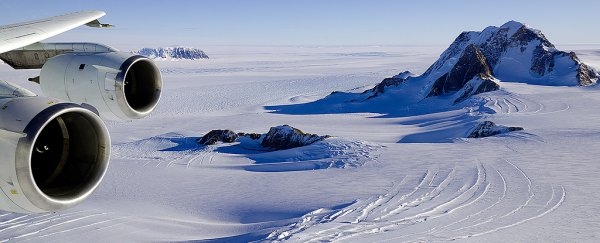Researchers have discovered what looks to be the largest volcanic region on Earth, revealing an invisible network of almost 100 unknown volcanoes lying hidden beneath the Antarctic ice sheet.
A remote survey of what's called the West Antarctic Rift System uncovered 138 volcanoes in total – 91 of which had never been detected before – and scientists say it's imperative we find out if any of these hidden peaks remain active.
"The big question is: how active are these volcanoes? That is something we need to determine as quickly as possible," geoscientist Robert Bingham from the University of Edinburgh in the UK told The Guardian.
"Anything that causes the melting of ice – which an eruption certainly would – is likely to speed up the flow of ice into the sea."
Bingham's team studied the rift system lying underneath the West Antarctic Ice Sheet, analysing ice-sheet bed-elevation data sourced from a database called Bedmap 2.
What they were looking for were conical edifices protruding upwards into the ice across West Antarctica – pretty much the same thing we see when topside volcanoes extend out of Earth's surface.
Of course, we can't physically see these volcano peaks when they're hidden underground, but ice-penetrating radar signals can detect their basalt rock forms within the ice sheet.
Some 47 subglacial volcanoes had previously been found in Antarctica, but the discovery of these 91 new peaks – along a region reaching approximately 3,500km (2,175 miles) between Antarctica's Ross Ice Shelf and the Antarctic peninsula – suggests there could be many, many more than scientists thought.
"We were amazed. We had not expected to find anything like that number," Bingham told The Guardian.
"I think it is very likely this region will turn out to be the densest region of volcanoes in the world, greater even than east Africa, where mounts Nyiragongo, Kilimanjaro, Longonot and all the other active volcanoes are concentrated."
The identified volcanoes extend in height from 100 metres (328 feet) to 3,850 metres (12,631 feet), and while the researchers don't yet know if any of them are active, it's important we find out.
Because these volcanoes are buried under kilometres of ice, it's unlikely they could pose a direct immediate threat to anything on the Antarctic surface – but if one were to erupt, it could heat and melt the ice above it, potentially rising sea level.
Aside from that concern, the researchers speculate that the activity of volcanoes could in fact be linked to their level of ice cover – or rather, the lack of it.
"The most volcanism that is going in the world at present is in regions that have only recently lost their glacier covering – after the end of the last ice age," Bingham said.
"Theory suggests that this is occurring because, without ice sheets on top of them, there is a release of pressure on the regions' volcanoes and they become more active."
As the true, extended scope of the West Antarctic Rift System has only recently been detected, it could be some time before we know the real impact of this discovery.
But it's a part of the world already undergoing tremendous, unrecognisable changes – so we can only hope this amazing find doesn't portend ominous news.
The findings are reported in the Geological Society's Special Publications.
